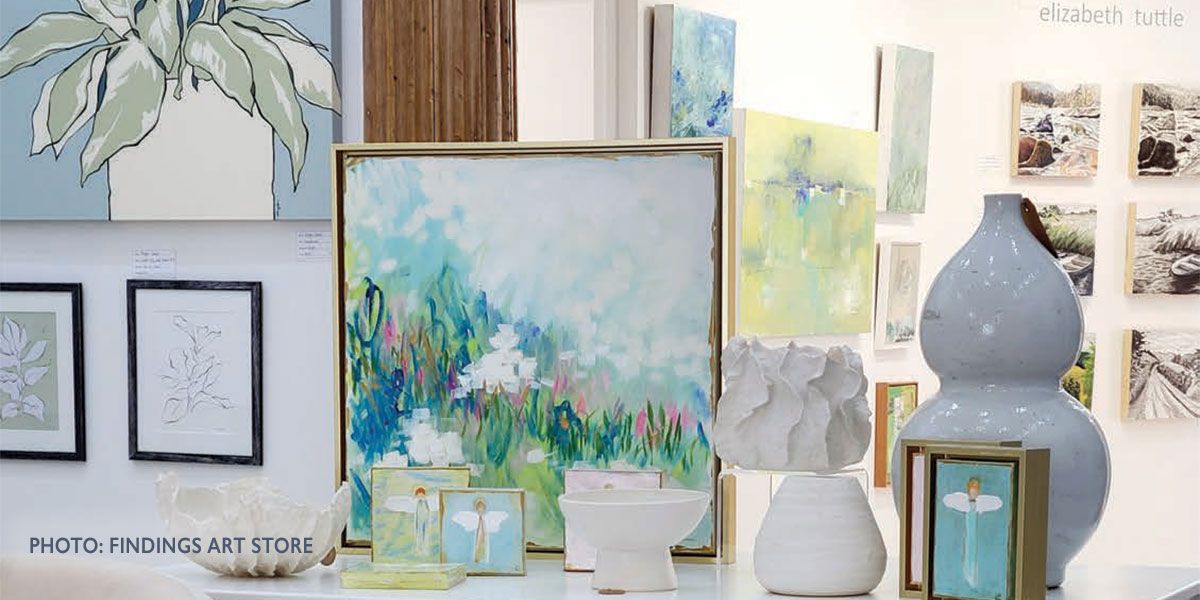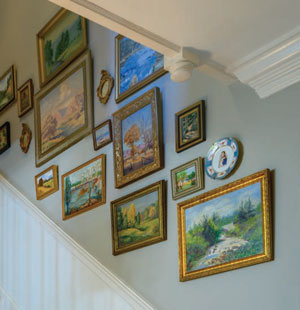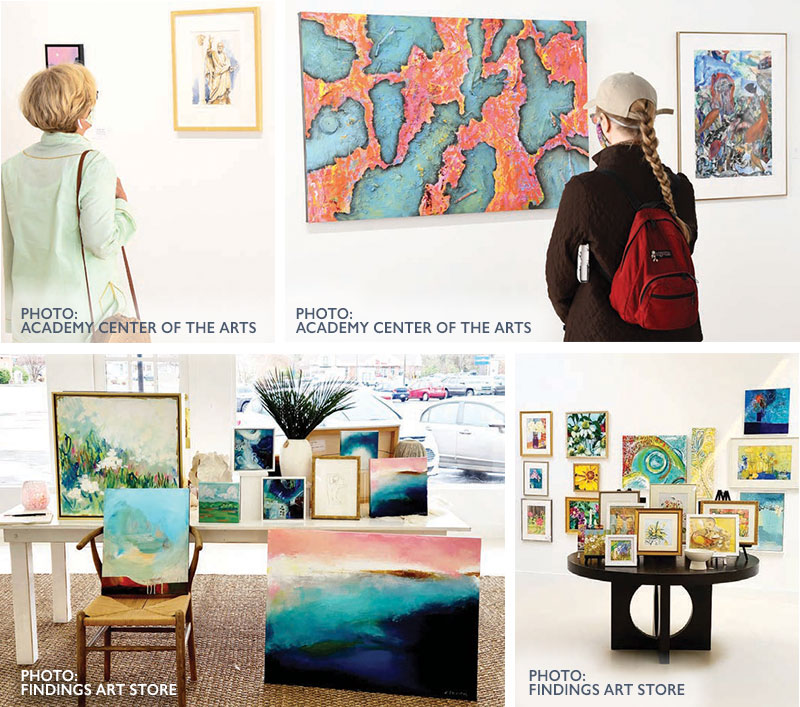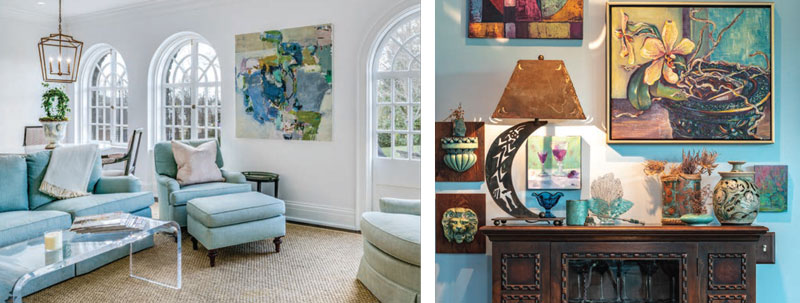A Love Affair with Local Art | Bring Color & Personality to Your Home

When you find a perfect painting for a blank wall, or a sculpture that makes your shelf complete, it can bring enjoyment to your everyday life. Owning a one-of-a-kind piece is an investment, but once you’ve experienced the dimension and color of an artist’s original creation on your wall, you might never go back to mass-produced prints. If you are looking to start or expand an at-home collection of original works, the Lynchburg region is bursting with talented artists in all genres.
“I moved to Lynchburg from Richmond in 2004, and I was almost immediately stunned by the vibrant art community here,” says Ted Batt, director of visual arts for the Academy Center of the Arts. “My perspective is that we have a lot of artists in town that are very talented.”
There are some rules to follow—and rules to break—when it comes to selecting art for a space in your home. There are also reasons to support local artists that may surprise you. Read on for advice on how to fill your home with beauty and never suffer from buyer’s remorse when you leave a gallery.
 Discover your likes
Discover your likes
If you’re new to appreciating and purchasing art, the best way to discover what speaks to you is by viewing a lot of work. Attend art shows, visit museums and galleries, and study the art at restaurants, shops and hotels. What subject matters speak to you? Do you favor a tight, realistic style, or a more loose, impressionistic style? Are abstracts for you, or do you like landscapes? When you discover an artist you like, follow them on social media, like Instagram or Facebook. Peruse the artist’s own feed, and you may discover other artists you like as well, and you can get a feel for the artists’ styles and processes from afar.
When it comes to purchasing, Amy Calandra Davis, who co-owns Findings Art Store with her husband Jimmy and has degrees in studio art and interior design, has a simple principle when deciding to bring a work home.
“I ask myself, if it’s something that I never see again, how sad would I be?” Davis says. “If I would be really sad, then I have to have it. If you love a work, you’ll find a place for it.”
Davis, like Batt, is impressed with the art scene in Lynchburg, and her confidence in it prompted her to open Findings, which has approximately 35 artists’ work for view and sale in the Boonsboro Shopping Center. Davis’ concept for the store was to have an ample gallery space that is constantly changing, so the store is never the same month to month. To that point, you should visit galleries and stores often, so you can see new works and figure out what you can’t live without. You might find that you gravitate to a certain palette, and you’ll likely find that you echo that palette in your other home decor choices, and even your wardrobe. Appreciating art is about pausing and noticing, and you may find that you begin to notice other details in your surroundings as well.
The value of buying local,
In the past several years, there has been a push toward buying local, and eschewing Amazon.com for supporting businesses in your area, which feed and strengthen the local economy. Art and artists are no exception.
“When you invest in local artists, so many of them give back to the local community through fundraiser donations of a painting or sculpture,” explains Batt, who says that beyond the economic question of keeping money in the local economy, a vibrant arts community makes a place like Lynchburg more attractive to newcomers.
“When people are considering a town, they might ask ‘What can I do culturally there?’” Batt says. A strong arts community includes artists, photographers, musicians and dancers, and shapes the cultural personality of a place. Buying art, just like buying tickets to a play, supports creativity and creation.
While very established artists may command a price for work that is out of your range, many emerging artists’ works are more reasonable, particularly if you are buying an unframed watercolor or pencil sketch, which you can find for as little as $75 to $100 and can frame inexpensively with an off-the-shelf frame; great options are available at stores like Homegoods and Target. While the high cost of paint supplies and canvases can bump up the cost of a canvas piece, you may still be able to find an original painting from an emerging local artist for a similar cost to a massproduced work.
A surprising reason to buy local is that it creates a connection between you and the artist. The artist created it, and you connected with the work in some way, which made you purchase it. Living in the same city or town means you have an opportunity to continually connect with that person, either through local shows, open studio days or even Instagram live sessions where the artist lets the viewer in on his or her process. When that work hangs on your wall, the greater understanding of the artist behind it can increase your appreciation for the piece.
“Lynchburg has an excellent art community and I’m not sure people realize how many very good artists we have,” says Davis. “I think by learning their names and seeing the work they do, it furthers your own pride in Lynchburg.”
 Practically speaking on size and hanging
Practically speaking on size and hanging
Yes, buying art is emotional, but choosing a place to hang it is a practical task. Most paintings will come with wire already attached to the back, but be sure you are using a hook that is rated for the weight of the piece to prevent any accidents or damage to your walls or the art. A natural tendency is to hang art too high, but a good guide is that the center of the piece should be at eye level, approximately 56 to 60 inches above the floor.
“I tend to gravitate toward large, dynamic pieces that fill the wall to some degree,” says Davis. “I’ve seen beautiful pictures of collage walls and spaces where every square inch is filled with artwork. It’s not my style but I appreciate it when it’s done well.”
How you hang artwork is a question of your own style. Do you prefer a clean, spartan look with fewer, large pieces, or do you like the eclectic and collected look? There is no right answer. If you have a collection of works you want to hang together, framing them in the same material can unite pieces that don’t seem to have any connection. If you need assistance, gallery owners or interior designers can assist with choosing a piece or pieces that work in a room, and many galleries will loan out items for a few days so you can try them before purchasing.
As to whether the palette of a painting needs to match the palette in a room, this is strictly personal preference. “I go back to, when I am in the room, is everything balancing to my eye?” Davis advises. “It’s fun to have some quirk here and there, so don’t be afraid to incorporate pop art with your landscapes. If you are comfortable with it, you are in your space more than your guests. Who cares if they like it? They’re leaving after dinner.”
Another practical item to keep in mind as you expand your collection is to catalog it, and verify insurance with your carrier. If you rent, a renter’s policy, or if you own, a homeowner’s policy, should cover most collections. Catalog works by taking photos and scanning receipts, as well as recording the artist and title of the work. Forward the document to your carrier so in the event of fire or flood, your investment is protected.
While art may appreciate in value if an artist gains prominence, no reputable art dealer would recommend a purchase as an actual investment. The payoff is the enjoyment of the piece, the beautification of your home, and the commitment to your community. ✦
art community, Interior Design, investment, Local Art, local economy, one-of-a-kind piece, studio art








